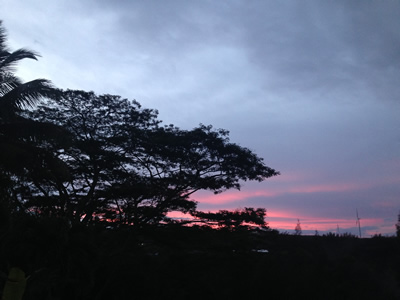Away in Oahu’s Wartime Memories
by Scott Thomas Anderson
Sierra Lodestar
The sailor held his bugle, waiting for the rifle fire. A bronze eagle touched the anchor of a clipper ship with its wings spread over the urn. When the shots finally came, their cadence cracked through an oleander garden of grass and headstones - a lonely piece of California far from the waves that nearly claimed my grandfather off the Mariana Islands. Like all survivors of the South Pacific, he’d rest now with the forgotten others, fading into flags and an American silence.
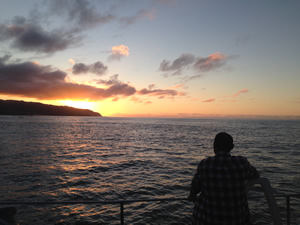
And who were those boys who’d braved the tropical horizon of smoke and fire, who’d risked it all in places like Tinian, Tarawa, Saipan and Iwo Jima? They were lean teenagers of the Depression. They were hard-luck youths who’d never seen a sunset beyond their own dusty county line. The attack on Pearl Harbor changed their fates. It steered them out under the endless skies over Midway. It brought them to the teal-ray waters of the Coral Sea. Sailing for vengeance meant sailing into a crucible. My grandfather was among of the bewildered prairie kids who ended up on the U.S.S. Colorado, an aging 630-foot, 33,000-ton battleship well past its prime. Like all navy men and Marines, his doorway to the cataclysm ahead was the Island of Oahu.
The wartime photos of Petty Officer Russell Lindgren arriving in Hawaii reflect a sense of wonder. Dressed in his sailor whites, his canvas hat cocked, he gazes at the high-spined, Jurassic mountains swelling over the shore. Another frame finds him wading through a lucent surf on Waikiki Beach in his old, belted swim trunks. The sky lights his face and his stare hints at how Oahu must have looked to all the wide-eyed faces arriving in 1942. These kids had never felt a lush, jungle breath on the back of their necks before. They’d never witnessed steam floating over speckled ‘iLima flowers or heard the batting murmur of wind rushing through breadfruit leaves. And what did they think when they first saw the cresting thunderheads slam over ragged palms and spear-tipped coconut blades, ghosting away within minutes, tearing into a blue and creamy radiance over mushroomed-spindled monkey pod branches? What was it like to step into another world?
I’ve searched for the Oahu my grandfather knew or anything that survives of the war-torn paradise that changed so many sailors and jarheads. For my own connection, there hasn’t been much to go on, save for one of my grandfather’s favorite stories, which involved the woeful jazz band assigned to the U.S.S. Colorado. “They were damn awful,” he would say. “We didnt care about them and we’d never go on deck to watch em‘.” But then, right before the Colorado left for the Pacific, a new sailor strolled up its gangplank. He was a clarinetist from New Orleans, and, as my grandfather always pointed out, “he played just like Pete Fountain.” While the battleship was cutting through blue waves toward Hawaii, this new musician was changing the band’s dynamic - and the ship’s energy.
“The other players just came to life trying to keep up with him,” my grandfather said with a smile. “Everything about the band changed. They were really swinging. Suddenly, we all wanted to go out and hear them.”
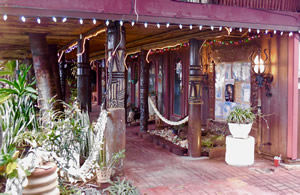
Searching for that music, I found myself on the back streets of Pearl City, at La Mariana’s, the last of Oahu’s original Tiki bars. The old sailing club opened a decade after Hiroshima, and as I stepped by its worn rattan chairs and carved Polynesian spirits - ducking under netted glass orbs and seashell dinner lamps - I caught a feeling of lost memories near the broken indoor waterfall. There aren’t spots in veterans’ cemeteries for an old bar like this.
Leaning against a faded village fence, I ordered a mai tai and stared at the sun-glazed yachts drifting out the window. I imagined my grandfather walking into a similar bar, his buddies coming in from the palm shade, a group of sailors ready to drink and listen to New Orleans swing roiling on the radio. Pete Fountain was a teenager during the war, yet when his clarinet rose to prominence a few years after, it would constantly remind my grandfather of the smiling Crescent City stranger who’d changed life on his battleship. Just hearing Fountain’s rendition of “Do You Know What It Means to Miss New Orleans” brought back those days at sea. Fountain was a doorway: It was something about how his clarinet’s riverside whistling swayed into smooth, drowsy shuffles, like the meandering turns of the Mississippi itself. I could envision shipmates swapping stories of home over Fountain’s take on “St. Luis Blues.” I could hear the free-flowing flutters and soprano break-stops, the way his cool, carousing notes calmed the muted snarls of a southern trumpet. For a moment, the gaudy island splendor of La Marianna’s held those fleeting echoes.
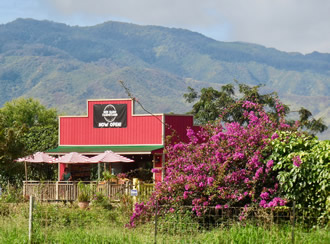
Days later, I felt the War in a breeze over Kamehameha Highway. Film from the National Archives shows servicemen cruising this countryside in military jeeps, passing the hatted farmers raking sugar cane, waving at sun-shaded islanders hoisting fruit crates from the tall grass. You can still find glimpses of that rural refuge on the edge of Hale’iwa: Pineapples, grapefruit, avocado and oranges are piled on the shelves of the Red Barn Farmstand, all harvested from the lush fields of a sugar plantation that sailors and Marines once marvel at. Today, the farmstand’s an open vista for sipping Kona coffee and glancing beyond its scarlet-peddled flowers to a tidal wave of emerald mountainsides. On a clear morning, the tip of the reaching terrain, Mt. Ka’ala, severs the white clouds, ripping them like gossamer as they move over the sparkling surf of the island’s north shore
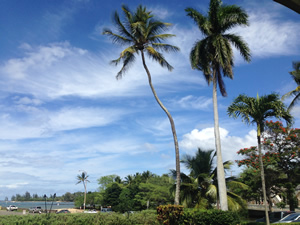
Hale’iwa has an even more direct window to the war years - those camel humps of concrete that form the Rainbow Bridge. The relic’s worn deckplate constantly trembled under jeep tires during the Peleliu Campaign, and it sits only a few miles from where two Air Force pilots made a desperate stand during the attack on Pearl Harbor. As bombs fell across the island, Ken Taylor and George Welch managed to launch their Curtiss P-40 Tomahawks off the Hale’iwa airfield. The pilots flew up into a hornets’ swarm of enemy fighters, ultimately sending six Japanese zeros into the earth. There’s no longer a hint of that bygone violence at the bridge: Travelers simply gaze on it from the patio of Haleiwa Joe’s, downing drinks and watching teenagers jump from its ledge, splashing into serene waters that flow into the harbor and then spread into a shimmering compass beyond Waialua Bay.
But the closest I’ve come to finding our Pacific warriors of the past is at Sharks’s Cove, wandering its beach at sunset. The blinding blade of the western horizon still glows from the direction of Midway. Clouds sail on the same darkening, star-pinned ocean that paints the edge of the waves. The jewel of the sky still reaches for the shore - still brings a slow, golden ebbing down the shields of the palm leaves. For the sailors and Marines on Oahu in 1942, what waited beyond those phosphorus glimmers was a storm of destruction. But they sailed into it nonetheless, shelling beaches, raiding hillsides and meeting Japanese forces head-on.
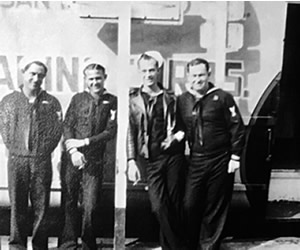
(My grandfather is the third from the left)
For my grandfather, the fighting began November 20, 1943 when the Colorado arrived at the island of Tarawa. His ship was an iron, shopworn bruiser, fitted with 406-mm guns, 76-mm antiaircraft guns, 25-caliber guns and two torpedo tubes. As U.S. Marines prepared to raid Tarawa’s jungles, the crew of the Colorado sighted-in Japanese positions and unleashed a hellish cannonade on the shoreline. Its 16-inch projectiles rained down on the breastworks. It draped smoke and fire across the beaches. The Marines took Tarawa in three days, pushing through a numbing blur of violence.
Next, the Colorado knocked out a Japanese gunnery at Saipan and provided call-fire on positions in the Marshall Islands. The ship had been lucky up until that point. But luck runs out. On July 24, 1944, the Colorado sailed close to the island of Tinian. It was searching for enemy targets when a massive hidden battery - a virtual wall of embedded guns - opened fire on it. Howling shells cut through the sides of the Colorado.
“That was when they hit us hard,” my grandfather recalled.
The Colorado fired back. Suddenly a blinding sea-to-shore artillery battle flickered over the waves. Each sailor in the U.S. Navy was trained to do three different jobs. Russell had been at an observation post when he was called to help operate one of the guns. The position he’d been standing at was soon obliterated. When the fight was over, Russel learned that 43 of his fellow crew members were dead. Dozens more were wounded.
The Colorado puttered back to Bremerton Naval Yard in Washington for repairs. My grandmother, Eunice Lindgren, waited at the dock with the other wives. Her heart nearly stopped when she saw the ship.
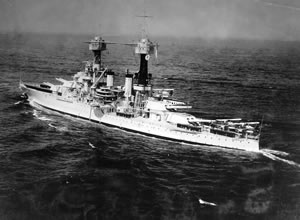
“There were holes in its side so big that you could drive a truck through them,” she remembered.
The Colorado was back in the fight by November of 1944, joining in the Battle of Leyte Gulf. This was the largest naval clash in modern history and a turning point for the victory at sea. During the clash, the Colorado’s crewmen found themselves frantically trying to shoot down Kamikaze pilots diving at the ship. There was no way to stop two of these speeding suicide planes from tearing into them. Some sixteen crew members were killed. Many more were burned or maimed.
“Still better than what our boys are dealing with in Iraq,” my grandfather told me in 2005, during a particularly gruesome evening newscast. “At least we could see our suicide bombers coming, and we could try to shoot them down.”
The tide of war had turned, but there was more fire for the Colorado to sail through. On January 9, 1945, the ship started bombarding enemy positions along the Lingayen Gulf in the Philippines. Out across the water, a crack gunnery crew, probably from the Japanese Royal Marines, carefully took aim. They sent a single heavy-caliber shell into the Colorado’s substructure, causing a raging cloud of fire to erupt through its navigation bridge and sky control. More than 21of the crew perished in oil and flames, and my grandfather saw horrors below deck that he never forgot - and only once told me about.
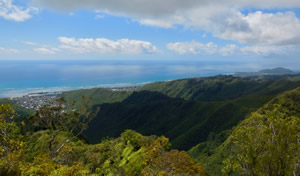
Nevertheless, the U.S.S. Colorado was one of the first American vessels to anchor in the waters off Tokyo after the surrender. The stern, outdated brawler had won seven battle stars. The war was over, but my grandfather would see the shallow currents off Pearl Harbor again. He’d glimpsed the batteries along a volcano called Puowaina rising over Honolulu, which would soon be the National Memorial Cemetery of the Pacific. And he’d still have some days on deck to see that Crescent City jazzman lifting an unbridled spirit through the other sailor-musicians. And what did my grandfather think when he later heard Pete Fountain’s “Sunset in Paradise,” with the clarinet’s rippling runs, its silky shudders, its drawn and moody boat calls fliting over the waters of memory? Did it bring him back to Oahu’s cool, music-filled bars, its green countryside and cane fields, its searing sunsets on the edge of Shark’s Cove?
Like many of his fellow crewmen - like many of his fellow WWII vets - Russell came home to work hard and live quietly and devote most of his energy to family. He never travelled abroad again. The War had been his one and only chance to see the world; and for him, it had been more than enough. A little California town called Pioneer became the only world that meant anything to him. Being there for his wife, his kids and his grandkids, was the real world he’d fought to protect. In the end, that was the world he was happiest to live in.
